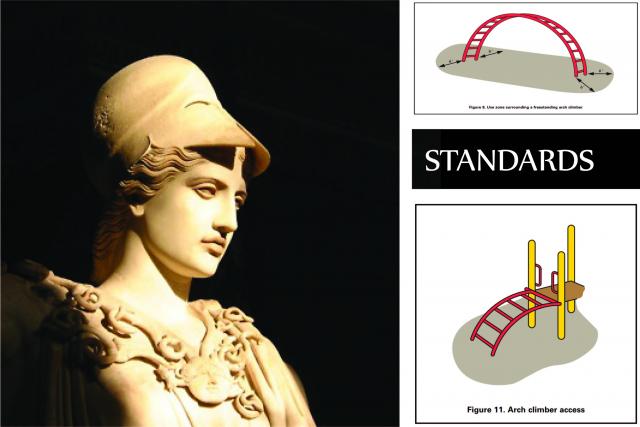
Pocket Park 2015

05/05/15
5) Standards :: Guidance, "B.3 Codes and Regulations: Ability to design sites, facilities and systems consistent with the principals of life-safety standards, accessibility standards, and other codes and regulations." - NAAB Student Performance Criteria :: The aim of this category is to acknowledge guidelines established by the U.S. Consumer Product Safety Commission. The purpose of this scrutiny is to not only prevent myself from overlooking inadvertent design hazards created in the design phase of the project, but achieve accordance with such regulations as well. :: The CPSC Public Playground Safety Handbook defines a public park as, ““Public”” playground equipment refers to equipment for use by children ages 6 months through 12 years in the playground areas of: Commercial (non-residential), child care facilities, Institutions, Multiple family dwellings, such as apartment and condominium buildings, Parks, such as city, state, and community maintained parks, Restaurants, Resorts and recreational developments, Schools, Other areas of public use.” The Handbook is divided into separate sections: Introduction (handbook revisions, definitions, etc.), General Playground Considerations (playground layout, recommended equipment, etc.), Playground Hazards (examples of potential hazards and solutions to avoid them), Maintaining a Playground (repairs, oversights, etc.), Parts of the Playground (descriptions of platforms, guardrails, interactive equipment, etc.), and finally the Appendices (test methods). Although I’ve read through the handbook extensively, I will provide summaries for each individual section. Under General Playground Considerations, a diagram is presented to aid in the search of a new site (A1). This passage later suggests that the park be separated into age groups, with bushes acting as buffer zones. Disabled persons need to be able to successfully access the park. Benches and any other seating should be able to view the playground equipment at all times. The passage then presents two new diagrams, one for examples of equipment determined age appropriate (A2), and one for appropriate surfacing (A3). Under Playground Hazards, the passage warns of structures that could crush, shear, entangle, impale, trip, and entrap children. Diagrams containing examples of how children may entrap themselves are then exhibited (A4). Under Maintaining a Playground, the passage recommends routine inspections to identify any potential hazards that need attention. Under Parts of the Playground, myriad examples of obstacles used in the design of a standard park are displayed via graphics, including measurements that should be implemented. For a complete compilation of these parts, see (A5). The Appendices sections indicate adequate test methods to ensure all equipment installed in the park are safe. I will take advantage of these methods in the Brainstorming phase of production.
This Step

What should I upload in this Collect Info step?
Help us understand the existing conditions and the location of this park. The following types of work should be uploaded:
- photos
- a short video
- site plan drawing of your existing parks or lot.

Bicycle Cities
Biking is a popular -& green!- way to travel. Yet if there is nowhere to lock up your bike, people may be discouraged to use their bike to get around. Did you know that you can Request a new bike rack in your area? Cities all over the U.S. have multiple types of bike racks they can install and all you have to do is submit a request. Where would you like to encourage people to use bikes instead of cars? CLICK HERE to learn about bicycling in Chicago.







Comments
(A1) http://modus2015.deviantart.com/art/A30-531314956
(A2) http://modus2015.deviantart.com/art/A31-531315272
(A3) http://modus2015.deviantart.com/art/A32-531315361
(A4) http://modus2015.deviantart.com/art/A33-531315427
(A5) http://modus2015.deviantart.com/art/A34-531315526
CREDIT:
CSPC Handbook (http://www.cpsc.gov//PageFiles/122149/325.pdf)
I appreciate your consideration of both the technical requirements as they relate to hazards, but also ADA compliant.
Thank you JG. The safety of the children who explore and reign about my park is absolutely crucial. Parents visiting shouldn't have to worry *too* much about the design of the park and its consciousness regarding the health of the child. Parents have a lot to stress about anyways, the last thing they need is a dangerous park! I made sure to consider not only the children, but the parents as well.